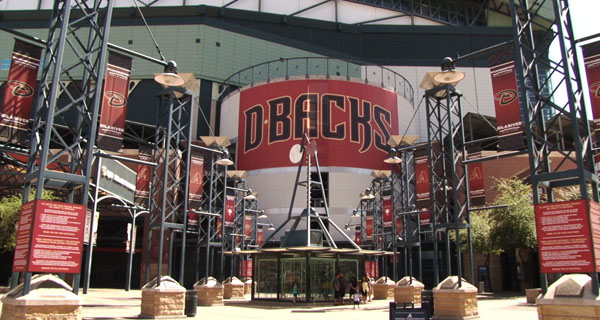
What is it like to catch a fly ball, run the bases, take batting practice or face a major league pitcher?
The Arizona Diamondbacks are allowing their fans to find out using innovative virtual-reality technology the team has unveiled at Chase Field.
Next door at Talking Stick Resort Arena, the Suns have introduced their season ticket holders to virtual reality with kits that were sent out in January. The team is also using the technology with some of its business partners.
The Diamondbacks added the Cox Connects VR Bullpen at Chase Field that lets fans use virtual-reality headsets provided there to get an inside-the-scenes look at what it’s like to be a Diamondbacks player.
“Our goal with Cox Connects VR Bullpen is to really bring fans as close to the action as possible,” said Graham Rossini, the Diamondbacks’ vice president of special projects and fan experience. “So with the headset, we basically put them in the middle of major league workouts (to experience) what it’s like to be in the batter’s box facing great pitching, what it’s like to be fielding ground balls, fly balls, etc.”
The VR Bullpen is available to fans from the time Chase Field’s gates open until the end of the seventh inning at each game.
“Only a few people get a chance to say they were a Major League Baseball player so when you do get to stand in the batter’s box and get to understand how good (Diamondbacks pitcher) Taijuan Walker is, how fast those pitches are coming in, the movement of a breaking ball, it’s a really cool perspective,” Rossini said.
There are five virtual-reality headsets available, allowing several fans at a time to experience the technology. Scenes include going inside the bullpen, running the bases, fielding ground balls, fielding fly balls and being inside the Diamondbacks dugout.
There are two monitors in the virtual-reality area, which is located on the concourse in center field, so that fans waiting for the headsets can see what other participants are experiencing.
“It’s really convenient,” said Sienna Villa, a member of the team’s in-game entertainment crew. “A lot of people walk by, so it’s a good place to have it. People will walk by and say, ‘What is that?’ The curiosity will lure them in.”
Rossini said there has been an average of about 350 fans visiting the virtual-reality area per game.
“It was so great to try it out,” Villa said. “It’s a great experience to be put into the situation the major league players are in. It’s cool to see them in the dugout when they are messing around before the game. It’s cool to be on the field with them while they are playing their game.”
The area has both HTC VIVE Virtual Reality headsets as well as Samsung Gear VR headsets. Rossini said as the virtual reality technology improves, the team is open to trying out new devices.
Discussions about bringing the technology to Chase Field began early last season.
The initial VR content was created during Cactus League play at Salt River Fields at Talking Stick in Scottsdale. The team positioned 14 cameras around the game field to capture 360-degree video from multiple locations.
“We had baserunning drills where the camera was right in the middle of a rundown,” Rossini said. “We had the camera in the middle of the cage during batting practice. We were in bullpen sessions having the catcher’s perspective of what it’s like. The beauty of spring training is really that behind-the-scenes footage that you can’t get during the year.”
The content was captured and produced by R&R Partners, a Phoenix marketing firm. New content, shot at Chase Field, will be added throughout the season.
“We got some great footage at Opening Day of the Opening Day lineups, the giant flag, the flyover, the walkoff celebration,” Rossini said. “So as we have big moments over the course of the season, our hope is to capture those and make those available in virtual reality.”
Even the Diamondbacks got into the virtual-reality experience. Rossini said during spring training the players were curious about the devices, and as they became more comfortable with having the cameras around, began interacting with them.
“The players are blown away,” Rossini said. “They give each other a hard time as well. They are pretty loose in the clubhouse and like to give each other a hard time whenever they can, so as they’ve had the experience (they’re) certainly talking about, ‘Hey, I can hit that pitch’ or, ‘Oh, how did you miss that ground ball?’ Kind of having some lighthearted fun with it.”
The Boston Red Sox are the only other MLB team to have a virtual-reality space in their ballpark.
“We saw it become a little more mainstream in sports and so a couple other teams have done it,” Rossini said. “The NBA has been using VR and not many baseball teams have taken advantage of it yet, so we really wanted to take advantage of the access we have at spring training and the fact that our players are really excited about the technology and baseball is such a unique game. There (are) so many fast moments using the technology to let fans look behind the scenes.”
Rossini said the team might even explore doing a virtual-reality game broadcast in the future.
“I think we are going to use this year to really test it out and capture a lot of content over the course of the season, make it available to fans month by month and then understand what the possibilities are moving forward,” Rossini said.

Suns aim for VR future to expand
The Suns are approaching virtual-reality technology in other ways, using it to market their product and those of their partners.
Suns President Jason Rowley said there are no plans for a virtual-reality area like the Diamondbacks have at Chase Field, but the Suns hope the technology can be another way to attract fans to games.
“It’s always that tension in sports, and we are not the only league or team to face this, but the at-home viewing experience is so terrific,” Rowley said. “You still want people to come to your game.”
“You have got to make sure you are doing the things in both areas of your business so that you are continuing to generate fan interest and fan affinity,” he said.
Rowley said there are so many NBA fans globally that only about 2 percent of the team’s fan base will ever actually attend a game at Talking Stick Arena. Knowing this, Rowley said there are advantages and disadvantages of trying to expand the virtual-reality access to those fans.
“Long-term, you want to develop obviously all of those relationships and be able to leverage that level of affinity,” Rowley said.
While virtual-reality access for all Suns fans is still is a work in progress, the team’s first jump into the world of VR was distribution of the kits to season ticket holders. Suns star Devin Booker is featured in the VR footage, urging season ticket holders to renew.
There also are VR clips of game and practice footage with a voiceover from Suns broadcaster Al McCoy. The content is all produced in-house.
“You have a pretty wide range of fans who are young and might have a better level of comfort with that type of technology and then you have some older fans where it’s something that they are not quite used to,” Rowley said. “There was an education process, but overall the feedback we got was terrific, and obviously something we will continue to build on.”
The Suns are also discussing using virtual reality in a basketball setting as a recruiting tool for potential free-agent signings. Rowley said it is a vision in progress and, as with everything, the Suns want to make sure they have perfected it before deploying it.
“When you have guys across the country, it might be a slick thing just to send them a phone and the VR to kind of show what it is like to play a game here in Phoenix,” Rowley said. “Not just here in the arena, but showcase the city as well. Go to some great locations, some restaurants, Old Town Scottsdale, the Phoenix Open, whatever, to kind of showcase what it’s like to live here so that’s another utilization.
“As you start thinking about it, it just opens up an entire world of possibilities in terms of being able to communicate with people on a different level, remotely.” Rowley said. “It still feels extraordinarily immersive, and (demonstrates) what it’s like to be here in the building, in a game, or somewhere else in the market as well.”
By Samantha Pell, Cronkite News




